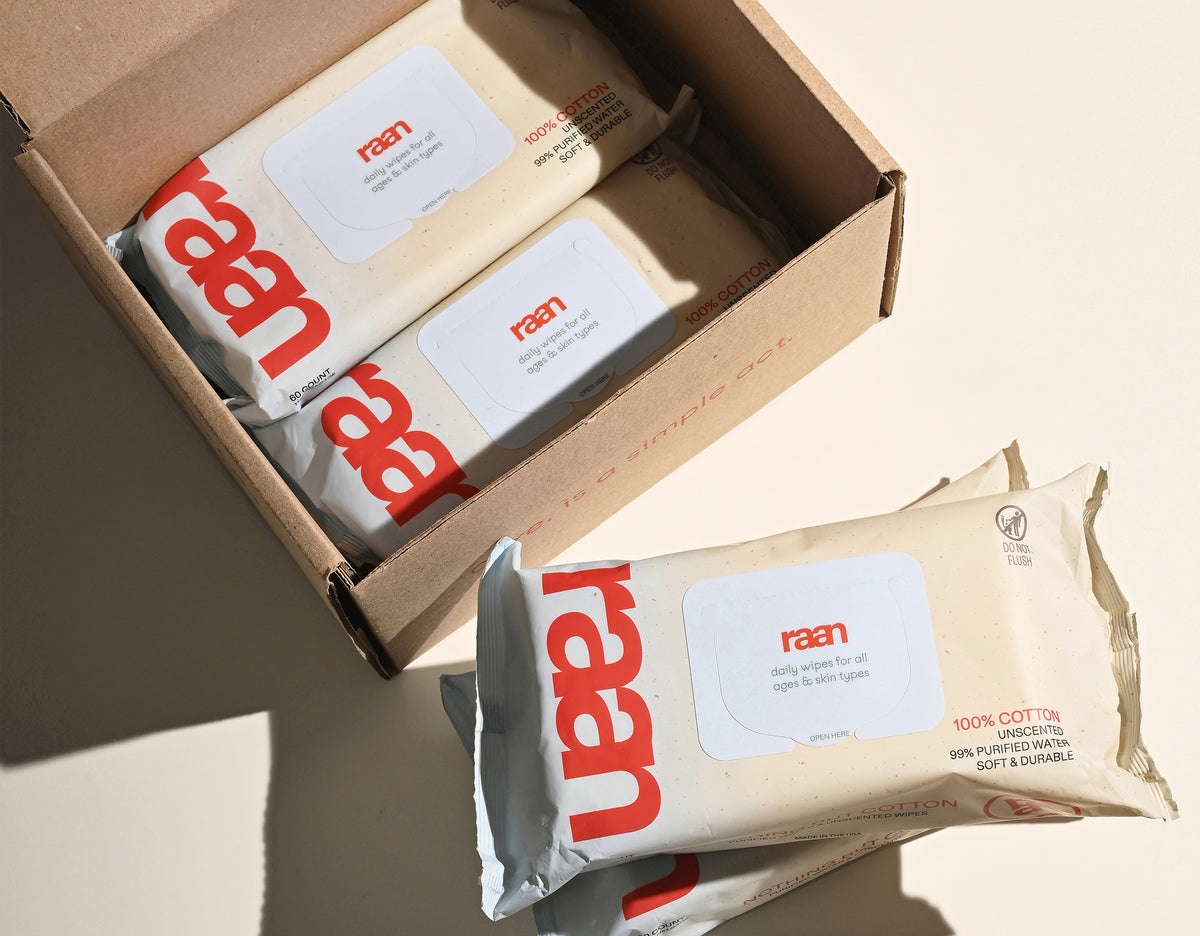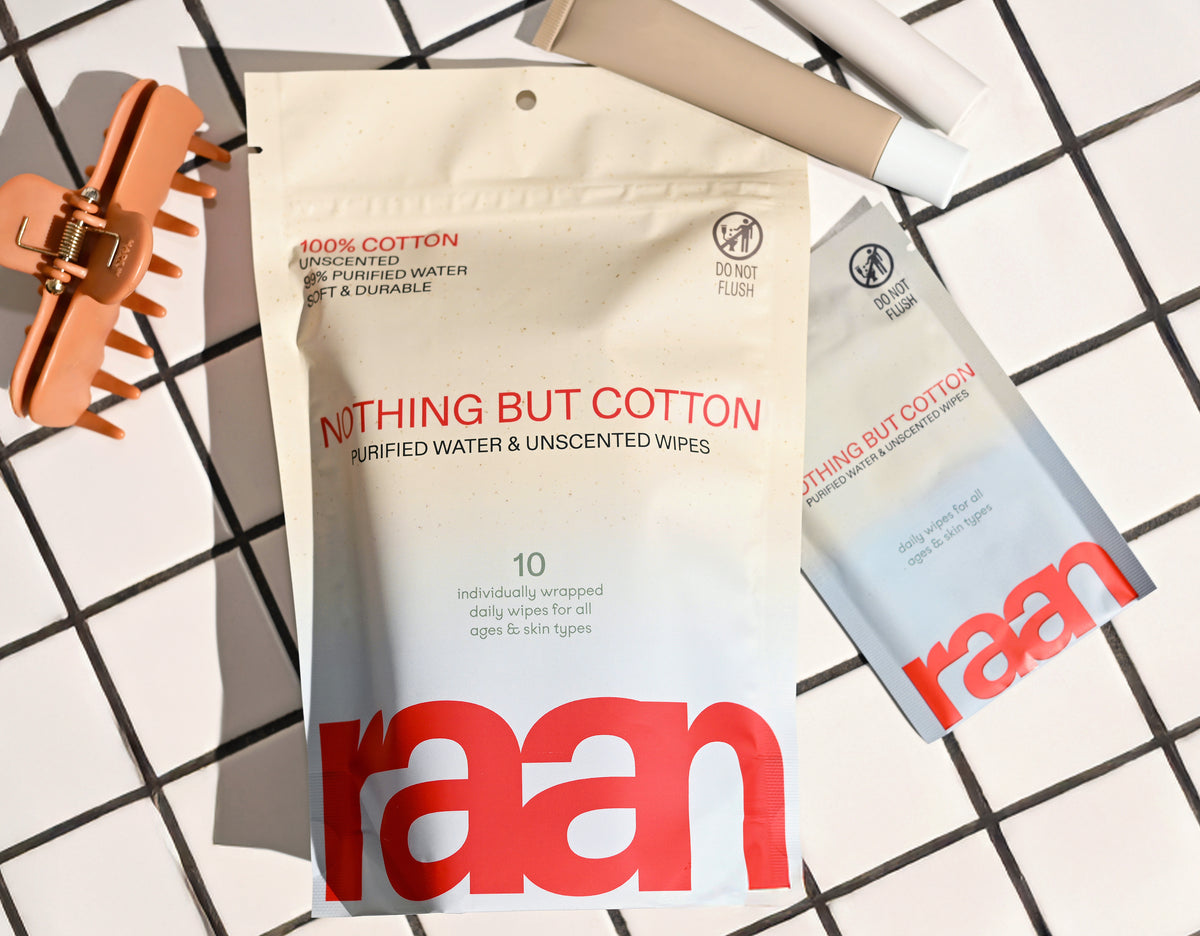Key Takeaways
- Not all sanitary wipes have the same quality or ingredients.
- The cleanest sanitary wipes are unbleached and made from 100% cotton.
- Using wipes with only five EWG-verified ingredients ensures safety and effectiveness.
- Avoid wipes containing plastic, harsh chemicals, or misleading marketing claims.
- Scientific evidence guides smarter choices for sanitary wipes.
Table of Contents
- What Are Sanitary Wipes?, Everyday Use, Real Ingredients, and True Simplicity
- The Science Behind Clean, How Do Sanitary Wipes Actually Work?
- Everyday Scenarios: How to Use Sanitary Wipes for Maximum Safety
- Choosing Your Wipes: Sensitive Skin, Sustainability, and What Clean Should Feel Like
- Sanitary Wipes Showdown: Wet vs. Dry, Synthetic vs. Plant-Based, and Beyond
- Environmental Impact: The Real Cost of Wipes (And What We're Doing Differently)
- Spotting and Solving Common Wipes Problems (Troubleshooting & FAQs)
- The Raan Difference, Transparent, Functional, and Built for Better Living
Sanitary Wipes: Real Science, Smart Choices Guide
Not all sanitary wipes are created equal. While most are packed with synthetic materials and mystery ingredients, the cleanest option might surprise you: unbleached, 100% cotton with just five EWG-verified ingredients. Here's what the science actually says about choosing wipes that work, without the plastic, chemicals, or marketing fluff.
Most conventional wipes contain polyester or rayon (plastic fibers), synthetic preservatives, and fragrances. Raan takes a different approach: unbleached, 100% cotton with purified water, organic aloe, and food-grade preservatives. That's it, no plastic, no bleach, no synthetic fragrances.
Sanitary wipes are versatile cleaning tools that go far beyond bathroom use. They're pre-moistened cloths for hands after playground visits, quick face refreshes at the gym, diaper changes, pet paw cleaning, and surface wipe-downs. The key difference lies in what they're made from and what's inside.
Quick-Answer: What Are Sanitary Wipes Made Of, Really?
- Conventional wipes: Polyester/rayon blend, synthetic preservatives, fragrance
- Cotton wipes: Natural fibers, minimal ingredients, EWG-verified safety
- 3 checks for clean wipes: Material source, ingredient count, independent certification
Common use cases:
- New moms tackling diaper messes and spit-up
- Skincare enthusiasts refreshing on-the-go
- Pet owners after muddy walks
- Anyone wanting gentle cleaning without harsh chemicals
The Science Behind Clean, How Do Sanitary Wipes Actually Work?
Sanitary wipes clean through mechanical action (physical removal) plus gentle conditioning agents. The cotton fibers lift dirt and bacteria, while ingredients like organic aloe soothe skin. Food-grade preservatives (sodium benzoate, potassium sorbate) prevent bacterial growth without synthetic chemicals.
| Ingredient | Function | Raan's Choice |
|---|---|---|
| Base Material | Physical cleaning | Unbleached, 100% cotton |
| Moisture | Dissolves dirt/oils | Purified water (99%) |
| Preservative | Prevents bacteria | Food-grade sodium benzoate |
| Skin Conditioner | Prevents drying | Organic aloe vera |
| pH Balance | Skin compatibility | Citric acid |
Misleading claims like "antibacterial" often mean harsh chemicals that can disrupt skin's natural barrier. Minimalist formulas work better for sensitive users, fewer ingredients mean fewer chances for irritation.
Ingredient red flags to avoid: Synthetic fragrances, methylisothiazolinone, plastic fibers, and anything you can't pronounce. If the ingredient list reads like a chemistry textbook, choose something simpler.
Everyday Scenarios: How to Use Sanitary Wipes for Maximum Safety

Proper technique matters. For hands, use one wipe and clean for 10 seconds, covering palms, fingers, and between digits. For face refreshing, gently pat, never scrub, and avoid direct eye contact.
Step-by-step for common uses:
- Baby care: Clean front-to-back, one wipe per area, dispose immediately
- Pet paws: Wipe between toes, check for cuts, never flush used wipes
- Surface cleaning: One pass for light cleaning, not a disinfectant replacement
- Gym refresh: Pat face gently, let skin air-dry for 30 seconds
Storage tips: Press packaging seals firmly closed, avoid heat exposure, and store in cool, dry places to prevent moisture loss.
Can I Use Sanitary Wipes Every Day?
Yes, if they're made with gentle, minimal ingredients like cotton and organic aloe. Avoid daily use of wipes with harsh preservatives or synthetic fragrances.
For more on choosing the right wipes for your needs, see our guide to the best wipes.
Choosing Your Wipes: Sensitive Skin, Sustainability, and What Clean Should Feel Like
The right sanitary wipes depend entirely on your skin's needs and values. New moms prioritize gentleness and safety certifications, while eco-conscious users focus on biodegradable materials and minimal packaging waste. Sensitive skin requires hypoallergenic formulas with fewer preservatives, and busy professionals want reliable cleaning without residue or fragrance.
Understanding label claims prevents costly mistakes. "Hypoallergenic" means fewer common allergens but isn't regulated, look for third-party verification instead. "Fragrance-free" excludes synthetic scents but may contain natural oils that irritate sensitive users. EWG Verified products undergo rigorous ingredient screening, making them safer for daily use on faces, hands, and babies.
4-Step Label Reading Guide
1. Check the material: Cotton over polyester or rayon
2. Count ingredients: Fewer than 10 signals transparency
3. Spot certifications: EWG, Cruelty Free, Natural Cotton Seal
4. Verify claims: "Biodegradable" should specify timeframe
Raan's unbleached, 100% cotton construction eliminates plastic microfibers that irritate sensitive skin and pollute waterways. Our EWG-verified formula uses just six ingredients, purified water, food-grade preservatives, skin-conditioning agents, and organic aloe, providing effective cleaning without synthetic fragrances, bleach, or unnecessary additives that trigger reactions.
If you're curious about the benefits of natural fibers, learn more in our article on unbleached cotton.
Sanitary Wipes Showdown: Wet vs. Dry, Synthetic vs. Plant-Based, and Beyond
Wet wipes excel at immediate cleaning, hands, faces, surfaces, while dry wipes require added liquid but offer longer shelf life and customizable moisture levels. Flushable wipes cause 93% of municipal sewer blockages according to water utility studies, despite marketing claims. Even "flushable" varieties take months to break down, compared to toilet paper's seconds.
Synthetic fiber wipes (polyester, rayon) provide durability but leave microplastics on skin and in landfills for decades. Plant-based materials like cotton and bamboo decompose within months while offering gentler texture for sensitive areas. Alcohol-based wipes kill 99.9% of germs but cause dryness and irritation with frequent use, choose alcohol-free for daily skincare and baby care.
| Criteria | Wet Wipes | Dry Wipes | Synthetic Fiber | Plant-Based/Cotton |
|---|---|---|---|---|
| Best For | Quick cleaning, travel | Custom moisture control | Heavy-duty surfaces | Sensitive skin, babies |
| Disposal | Trash only | Compostable options | Landfill waste | Biodegradable |
| Decomposition | Months to years | Weeks to months | 50+ years | 3-6 months |
| Skin Safety | Formula-dependent | User-controlled | May cause irritation | Naturally gentle |
Cotton-based sanitary wipes like Raan's provide the ideal balance: pre-moistened convenience with biodegradable materials that won't clog pipes or irritate skin. Our unbleached cotton eliminates harsh processing chemicals while maintaining durability for effective cleaning across multiple uses.
For those who want a convenient option for travel or on-the-go, try the mess-ready pack for all your cleaning needs.
Environmental Impact: The Real Cost of Wipes (And What We're Doing Differently)

Traditional wipes contribute 11% of marine plastic debris, with synthetic fibers persisting for decades in waterways and soil. Most conventional wipes contain polyester or polypropylene that fragment into microplastics, entering food chains and drinking water. Even "biodegradable" claims often require industrial composting facilities unavailable to most consumers.
Packaging compounds the problem, standard wipe containers use 3x more plastic than necessary, with hard lids and non-recyclable pouches. Raan eliminates 70% of packaging plastic by skipping rigid dispensers, using pouches with 35% post-consumer waste, and 100% recyclable outer boxes. Our unbleached cotton decomposes naturally without industrial processing requirements.
Environmental Facts
Cotton wipes: Biodegrade in 3-6 months in home compost
Synthetic wipes: Persist 50+ years, fragment into microplastics
Annual wipe waste: 20 billion units in US landfills
Real change starts with informed choices. Always dispose of sanitary wipes in trash, never flush, even "flushable" varieties. Choose EWG-verified products with minimal packaging and natural materials. Share knowledge with family and friends to multiply impact across communities committed to cleaner living.
For a deeper dive into the science of wipes and their environmental impact, see this peer-reviewed article on wipes and microplastics.
Spotting and Solving Common Wipes Problems (Troubleshooting & FAQs)
Skin irritation from sanitary wipes typically stems from synthetic fragrances, methylisothiazolinone preservatives, or polyester fibers. Switch to unbleached cotton wipes with food-grade preservatives to eliminate common triggers. For immediate relief, rinse affected areas with cool water and apply fragrance-free moisturizer.
Dried-out wipes result from poor seal integrity or heat exposure. Store containers away from direct sunlight and press pouches firmly closed after each use. Transfer remaining wipes to airtight containers if original packaging fails, adding a few drops of purified water can restore moisture without compromising safety.
Quick Patch Test Method
Step 1: Apply small amount behind ear
Step 2: Wait 24 hours without washing area
Step 3: Check for redness, itching, or swelling
Safe if no reaction appears
Residue buildup indicates heavy synthetic ingredients or inadequate water content. Quality wipes like Raan's minimize residue through balanced formulation, 99% purified water with minimal conditioning agents that absorb completely. Never flush any wipes, regardless of "flushable" claims. Use sealed disposal bags for travel and home compost bins for truly biodegradable options.
Wondering how many wipes you might need for your family? Check out our guide on how many wipes do I need for practical tips.
The Raan Difference, Transparent, Functional, and Built for Better Living
Raan transforms the sanitary wipes industry through radical simplicity, six EWG-verified ingredients instead of dozens of synthetic additives. Our unbleached, 100% cotton construction eliminates plastic microfibers while providing superior absorbency and gentleness for sensitive skin, newborns, and daily skincare routines.
Third-party certifications validate our commitment: EWG Verified ensures ingredient safety, Natural Cotton Seal confirms material purity, and Women Owned reflects our values-driven approach. Recognition through the 2025 Baby Innovation Award and National Parenting Product Awards demonstrates real-world performance trusted by families nationwide.
What Raan Stands For
• Ingredient transparency: Every component explained, nothing hidden
• Material integrity: Unbleached cotton, never synthetic fibers
• Environmental responsibility: 70% less plastic packaging
• Universal safety: Gentle enough for newborns, effective for adults
Whether you're a new parent navigating overwhelming product choices, a skincare enthusiast seeking gentle cleansing, or a pet owner managing daily messes, Raan simplifies clean care without compromise. Join the movement for honest, functional products, because clean shouldn't require complicated ingredient lists or environmental trade-offs.
Experience the difference that comes from choosing sanitary wipes designed with intention, crafted with integrity, and built for the real, everyday moments that matter most.
For additional scientific insights on the microbiology of wipes and their effect on skin, see this recent study in Frontiers in Microbiology.
Frequently Asked Questions
What ingredients should I look for to ensure sanitary wipes are safe and effective?
Look for wipes made with minimal, EWG-verified ingredients like purified water, organic aloe, and food-grade preservatives such as sodium benzoate and potassium sorbate. This simple, transparent formula ensures safety and effectiveness without unnecessary additives or harsh chemicals.
How do unbleached, 100% cotton sanitary wipes differ from conventional wipes made with synthetic fibers?
Unbleached, 100% cotton wipes use natural fibers that are gentle on skin and free from plastic microfibers found in synthetic blends like polyester or rayon. They avoid harsh bleaching processes and synthetic materials, offering a cleaner, safer, and more environmentally responsible option.
Why is it important to avoid sanitary wipes with synthetic fragrances and harsh chemicals?
Synthetic fragrances and harsh chemicals can irritate sensitive skin and introduce unnecessary toxins. Avoiding these ingredients reduces the risk of allergic reactions and supports a truly gentle, safe wipe that respects both your skin and overall health.
In what everyday situations are sanitary wipes most useful, and how can I use them safely?
Sanitary wipes are handy for quick cleanups after diaper changes, refreshing skin on-the-go, wiping pet paws, or cleaning hands after outdoor play. Use them as a gentle, effective tool by choosing wipes with simple, safe ingredients and natural fibers to protect skin and avoid irritation.






